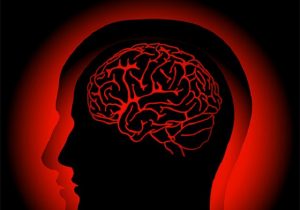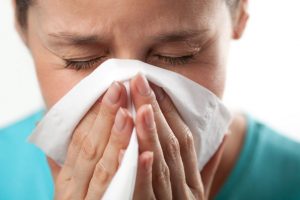Meningococcal infection – occurs everywhere, most often from December to May, affects mainly children, especially the first year of life, but diseases are possible in adults as well.
 Causative agent of infection (meningococcus) it is transmitted by airborne droplets from a patient or a carrier to a healthy person during coughing, sneezing, talking or kissing, penetrates into the nasopharyngeal mucosa and multiplies in it. Some become carriers of meningococci, highlighting them in the external environment.
Causative agent of infection (meningococcus) it is transmitted by airborne droplets from a patient or a carrier to a healthy person during coughing, sneezing, talking or kissing, penetrates into the nasopharyngeal mucosa and multiplies in it. Some become carriers of meningococci, highlighting them in the external environment.
The number of “healthy” carriers is hundreds of times the number of patients.
The disease occurs within two to three days from the moment of infection. Depending on the degree and severity of the course, two clinical forms of meningococcal infection are distinguished: localized (inflammation of the nasal mucosa and pharynx — nasopharyngitis) and generalized (when meningococcus enters the blood).
 Localized form of infection (nasopharyngitis):
Localized form of infection (nasopharyngitis):
- acute onset of the disease;
- dry mouth and frequent need for drinking;
- tickling and sore throat when swallowing, runny nose, cough;
- swelling of the posterior wall of the nasopharynx;
- headache;
- subfebrile temperature (37-37.9 ° C).
Recovery occurs in 5-7 days.
Generalized form of infection:
- a sharp deterioration in health;
- severe, sometimes intolerable headache, pain in muscles and joints;
- repeated vomiting and the appearance of a hemorrhagic rash on the legs, buttocks, torso;
- severe intoxication of the body (thirst, pallor and dry skin, coated tongue, lack of appetite);
- violation of the heart, lowering blood pressure;
- in children, convulsions and trembling of the extremities are possible.
In severe cases of the disease, the brain and its membranes (meningitis or meningoencephalitis) are affected, and meningococcal sepsis can develop.
Meningitis (inflammation of the meninges) occurs 1-2 days after the pathogen enters the body and develops within 3-4 days.
His manifestations:
- growing anxiety, the child cries, complains of a headache, he is irritated by the light, conversations, sounds;
- high temperature, which may decrease for a short time, which should not be considered a sign of a fracture during the course of the disease and refuse hospitalization;
- drowsiness, short-term convulsions, motor restlessness, agitation, especially in young children;
- trembling of the eyelids and limbs, especially of the hands;
- repetitive vomiting (without nausea), not associated with eating or medication (sometimes the disease begins with vomiting);
- increased sensitivity of the skin, because of what the child cries when touched;
- intense or beginning to protrude a large spring in infants.
 Meningoencephalitis (inflammation of the substance of the brain and meninges) is characterized by prolonged disorders of consciousness, convulsive syndrome, paresis of cranial nerves and extremities, mental disorders.
Meningoencephalitis (inflammation of the substance of the brain and meninges) is characterized by prolonged disorders of consciousness, convulsive syndrome, paresis of cranial nerves and extremities, mental disorders.
The key to a favorable outcome of the disease is timely hospitalization of the sick.
Meningococcal sepsis (blood poisoning) is often combined with meningitis..
It is typical for him:
- sudden onset (lethargy, chills, vomiting, fever to high numbers);
- convulsions and loss of consciousness;
- the appearance of a rash (by the end of the first day) in the form of stars of irregular shape and of various sizes, pink, red or purple, tending to merge, on the outer surfaces of the thighs, shins and shoulders, buttocks, somewhat less often on the body and face.
Residual effects and complications of meningococcal infections are more common in patients whose treatment is started late.
The fulminant form is especially dangerous when the disease develops rapidly and death may occur within a few hours.
Special attention requiring people:
- those who have been in contact with the patient;
- with complaints of sudden severe headache, dizziness, vomiting, weakness, trembling of drooping eyelids, hands, body trembling during an outbreak of meningococcal infection.
With timely diagnosis and modern methods of treatment, meningococcal infection proceeds favorably, ends with recovery without any consequences.
Preventive measures:
- prompt medical attention at the slightest suspicion of meningococcal infection;
- early isolation and hospitalization of the patient with meningococcal infection;
- isolation of family members with suspected flu, laryngitis, acute respiratory viral infection;
- processing premises and dishes using soap-soda solutions.
Preventive vaccination against meningococcal infection in the country is not carried out (the feasibility of its implementation has not been studied enough in the world).
Children are more likely than adults to be at risk of contracting meningococcal disease.
To protect the child from excessive contact with other people:
- walk with him outdoors only;
- Avoid traveling with a small child in public transport and visits to places where there is a high density of people (shops, markets, hairdressers, concert and cinema, etc.);
- hold any celebrations, including those related to the birth of the baby, outside the apartment – in a restaurant, dining room and more, that is, in his absence.
Often, the parents themselves or close relatives who, having underestimated their condition (malaise, seeming cold), continue to care for the child, continue to care for it, putting the child in mortal danger.
If you suspect a disease, call the doctor at the house of the child or contact the clinic. If the symptoms of the disease increase very quickly, call an ambulance or take the child to the hospital immediately (preferably accompanied by a health worker).
For any questions regarding the prevention of meningococcal disease, please call +375-162-23-88-78, +375-162-23-62-10.
According to the materials of the State Institution “Brest Regional Center of Hygiene, Epidemiology and Public Health”


